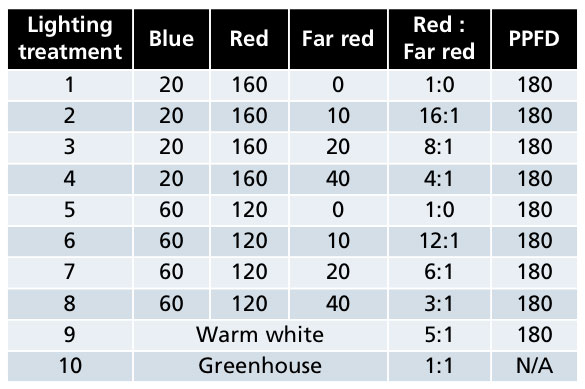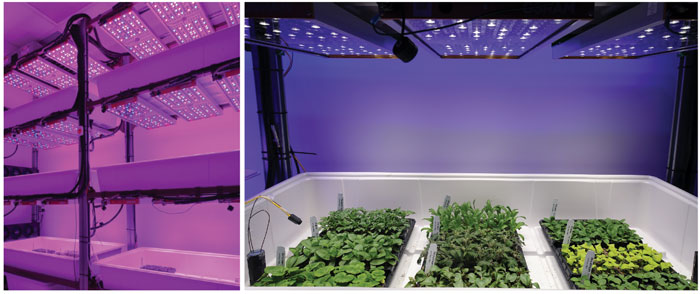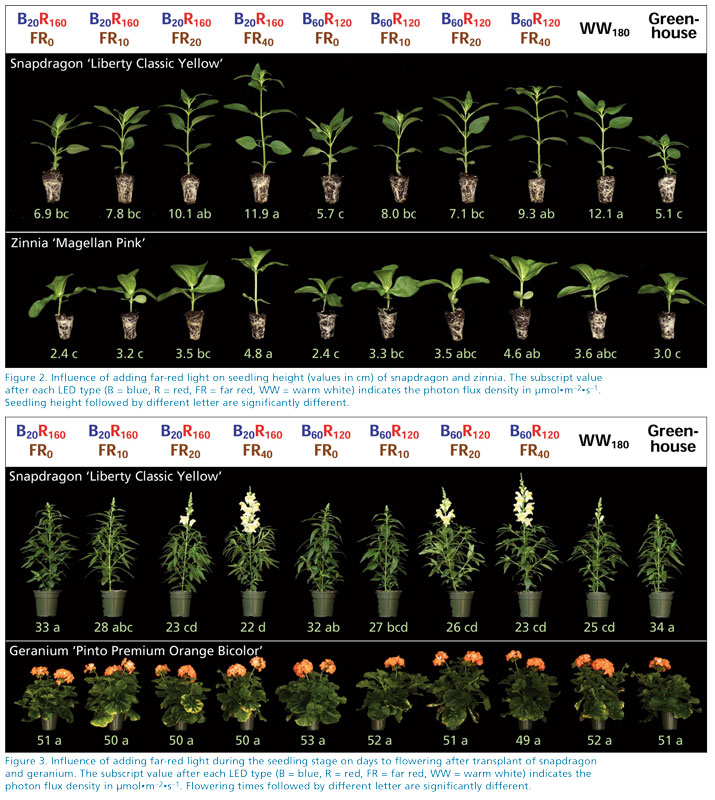5/1/2019
A Little Far-Red Light Goes a Long Way
Mengzi Zhang, Yujin Park & Erik Runkle

Light-emitting diodes (LEDs) are increasingly being used for indoor production of high-value specialty crops such as leafy greens, microgreens and herbs. There’s also heightened interest in growing high-value floriculture transplants (plugs and liners) indoors. Indoor production can produce more consistent and uniform transplants, reduce shrinkage and the use of growth retardants, and reduce crop time after transplant.
LED fixtures for plant applications generally come in two types: ones that emit white light and others that emit purple or pink light. The pink/purple light comes from red (R, 600 to 700 nm) and blue (B, 400 to 500 nm) LEDs that are combined on a fixture, while white light-emitting fixtures are primarily composed of white LEDs. The R+B LEDs emit essentially no far-red (FR, 700 to 800 nm) light, while white LEDs emit a low percentage of FR.
One of our research foci has been to better understand the pros and cons of including FR in a lighting spectrum. In general, adding more FR (or decreasing the R-to-FR ratio) promotes stem elongation, leaf expansion and sometimes overall growth.
In addition, it can decrease leaf chlorophyll concentration, which makes leaves appear slightly less green. The addition of FR also accelerates subsequent flowering in some long-day plants. We performed an experiment to learn more about how much FR light is needed to elicit desired plant responses in a range of floriculture crops.
Experimental protocol
We selected floriculture crops for study based on their differing tolerances to sun and shade, as well as their different flowering responses to photoperiod. Seeds of three long-day plants (Dianthus Jolt Cherry, Petunia Wave Blue and Snapdragon Liberty Classic Yellow), three short-day plants (African Marigold Antigua Orange, Coleus Wizard Golden and Zinnia Magellan Pink) and three day-neutral plants (Geranium Pinto Premium Orange Bicolor, Impatiens Super Elfin XP Red and Tomato Micro Tom) were sown in 128-cell plug trays by Raker-Roberta’s. Impatiens and coleus are shade-tolerant plants while the others are shade-avoiding plants.
 Table 1. The photon flux density (values in µmol•m–2•s–1) of blue (400 to 500 nm, peak = 449 nm), red (700 to 800 nm, peak = 664 nm) and far-red (700 to 800 nm, peak = 733 nm) light, the ratio of red to far-red light, and total photosynthetic photon flux density (PPFD, 400 to 700 nm) delivered in nine indoor lighting treatments and one greenhouse treatment.
Table 1. The photon flux density (values in µmol•m–2•s–1) of blue (400 to 500 nm, peak = 449 nm), red (700 to 800 nm, peak = 664 nm) and far-red (700 to 800 nm, peak = 733 nm) light, the ratio of red to far-red light, and total photosynthetic photon flux density (PPFD, 400 to 700 nm) delivered in nine indoor lighting treatments and one greenhouse treatment.
Upon emergence of the first true leaf for each crop, plug trays were placed on vertically stacked shelves under nine lighting treatments (Table 1) inside the Controlled Environment Lighting Laboratory at Michigan State University (Figure 1). Four intensities of FR light (0, 10, 20 and 40 µmol•m–2•s–1) were added to two different combinations of B+R light. Another treatment was light from warm-white LEDs and the last treatment was delivered in a research greenhouse, with the same photoperiod and similar temperature and daily light integral (around 12 mol•m–2•d–1).
On each shelf indoors, lights were operated for 18 hours per day at constant 68F (20C). Once plants were ready for transplant, which was three to five weeks under the lighting treatments, we collected the following data: stem length, leaf number, leaf area and dry shoot weight. We also measured the relative chlorophyll concentration on the leaves of geranium, coleus, petunia and zinnia seedlings using a SPAD meter. One of our objectives was to determine the effects of the light spectrum on plant height, and thus, no plant growth regulators were applied.
After the lighting treatments, seedlings of each crop were transplanted into 4-in.  pots and grown until flowering in a common greenhouse environment at 68F with a 16-hour photoperiod. We recorded date of visible flower bud, date of flowering, number of flowers or inflorescences at flowering, and plant height at flowering. We performed the study twice and data were analyze statistically.
pots and grown until flowering in a common greenhouse environment at 68F with a 16-hour photoperiod. We recorded date of visible flower bud, date of flowering, number of flowers or inflorescences at flowering, and plant height at flowering. We performed the study twice and data were analyze statistically.
Figure 1. Indoor lighting treatments were delivered on vertically stacked shelves in the Controlled-Environment Lighting Laboratory at Michigan State University.
Research results
Seedling growth. Leaf area, leaf number and dry shoot weight of all species were generally similar among the 10 treatments. Only in snapdragon and zinnia stem length increased, as more FR light was added to B+R light, regardless of the B light intensity.
For example, adding 40 μmol•m–2•s–1 of FR to B+R light increased plant height of snapdragon by 64% to 134% and zinnia by 52% to 96% compared to seedlings grown in the greenhouse or indoors without FR light (Figure 2). In petunia, stem length was two times taller in the greenhouse than the indoor treatments without far red.
Pigmentation. The addition of 40 μmol•m–2•s–1 of FR decreased the relative chlorophyll concentration of petunia by 16% to 23%, regardless of B light intensity. Similarly, it decreased in zinnia by 17% under 80 μmol•m–2•s–1 of B light. Without FR, increasing B light intensity increased the relative chlorophyll concentration of zinnia by 14% and petunia by 13%. However, this effect was diminished, as FR was added to B+R light, regardless of the B light intensity. In geranium and coleus, the relative chlorophyll content was similar among lighting treatments.
Subsequent flowering. The lighting treatments during the seedling stage had little to no effect on time to subsequent visible bud or flower, flower number, or plant height at flowering in all the species tested except for snapdragon (Figure 3). In snapdragon, subsequent flowering was accelerated by seven to 11 days when 20 or 40 μmol•m–2•s–1 of FR was added to B+R light (regardless of B light intensity) compared to those grown without FR indoors or under greenhouse conditions. Plant height of snapdragon at flowering was also 17% to 32% shorter with the addition of 10 to 40 μmol•m–2•s–1 of FR or under warm-white LEDs compared to B+R light without FR.
Conclusions
In this study, we tested the utility of including a low intensity (10 to 40 μmol•m–2•s–1) of FR light in an indoor lighting spectrum for a wide range of floriculture transplants. During the young plant stage, a low intensity of FR had little to no effect on seedling growth in any species. In two high-light plants (snapdragon and zinnia), stems were taller and leaves were paler green with 40 μmol•m–2•s–1 of FR.
A relatively low intensity (20 or 40 μmol•m–2•s–1) of FR light during the young plant stage accelerated subsequent flowering of the long-day plant snapdragon. In day-neutral or short-day plants, the addition of FR light had no effect on flowering time. Plants under the higher intensity of blue light generally had a greater chlorophyll concentration and so leaves were darker green, but the addition of FR diminished this effect.
We conclude that when lighting a wide range of floriculture plants indoors, including 20 μmol•m–2•s–1 of FR light with at least 20 μmol•m–2•s–1 of B light, it will produce moderately compact seedlings without delaying the subsequent flowering of sensitive long-day plants. GT

Acknowledgements: We thank the American Floral Endowment, OSRAM Innovation, Michigan State University’s AgBioResearch, and Floriculture Research Alliance partners and horticultural companies for supporting research and outreach programs at MSU. We also thank Raker-Roberta’s, Syngenta Flowers and PanAmerican Seed for donation of plant material, and Nate DuRussel for technical assistance.
Mengzi Zhang received an M.S. degree at Michigan State University (MSU) and is currently a Biological Scientist at the Mid-Florida Research & Education Center, University of Florida. Yujin Park is a postdoctoral research associate and Erik Runkle (runkleer@msu.edu) is a Professor and Floriculture Extension Specialist in the Department of Horticulture at MSU.